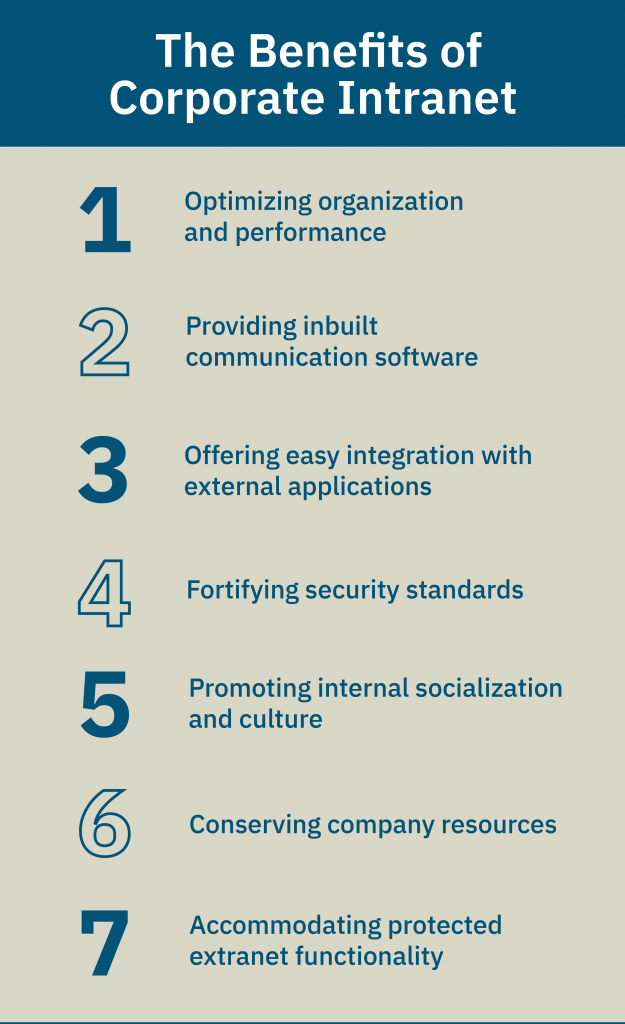With remote work and telecommunications now occupying a central role in modern business, corporate intranet can optimize the internal potential for collaboration, organization, discussion, and engagement. By keeping company data and workflows centralized on a private network, intranet is also a safer, more efficient means of conducting digital business. Well-designed corporate intranets provide a variety of benefits, including:
- Optimizing organization and performance
- Providing inbuilt communication software
- Offering easy integration with external applications
- Fortifying security standards
- Promoting internal socialization and culture
- Conserving company resources
- Accommodating protected extranet functionality
Keep reading to learn about the manifold ways in which corporate intranet systems are evolving to revolutionize the modalities and landscapes of the modern business sector.
The Fundamentals of Corporate Intranet
Historically, the development of both the Internet and intranet systems are deeply embedded, though the intranet definitively diverged circa 1994 and has continued to evolve in sophistication over the course of the following decades. Intranet platforms were shaped by the growing popularity of social media in the early aughts, treating communication as a centrifugal business tool rather than an extraneous operating feature.
Corporate intranet networks can come ready out of the box from providers like SharePoint. They can also be designed by SharePoint experts or other provider experts with additional site templates, page layouts, and features. They can even be custom built.
These networks draw on much of the same infrastructure as public networks (re: the Internet itself using HTTP, SMTP, and FTP). They serve as private extensions meant to coalesce company communications and private data. A single intranet network can encompass hundreds—even thousands—of employees, workflows, team channels, documents, datasets, and third-party applications.
Intranet networks are used by organizations of all sizes and across almost every industry, including the federal government, academic institutions, healthcare facilities, private equity firms, and small businesses across the world. Today, the International Association for Human Resource Information Management (IHRIM) estimates that over 85% of companies rely on intranet services or centralized employee portals of some kind.
How Intranet Networks Diverge from Standard VPNs
While intranet networks and standard VPNs draw upon the same basic principles of proactive cybersecurity, VPNs still utilize larger public networks to funnel encrypted data. By contrast, intranets can (and often do) operate completely independent from the Internet. For maximum security, users may opt to deploy their corporate intranet systems through VPNs should their company choose to integrate functional Internet capabilities into their intranet platforms.
The Benefits of Corporate Intranet
Let’s further examine the intricacies of corporate intranet and the ways in which it empowers internal business by providing a collaborative landscape for teams to operate, conduct business, and share internal data.

1. Optimizing Organization and Performance
- Automated scheduling software within corporate intranet networks make it easier to synchronize staff calendars and block out collective timeframes for meetings, scheduled vacation time, and flex hours.
- Intranet also simplifies workflows through centralized delegation on a unified platform. Teams have shared access to meeting itineraries, initiative objectives, and personal responsibilities within a given project or department.
- Such systems also tend to inspire upticks in levels of employee engagement due to user-friendly software designed to foster communication, collaboration, and peer-to-peer teamwork.
- Often equipped with internal search engines, intranet systems keep files organized and accessible. They also alleviate the administrative burdens placed on inundated HR departments.
- Case studies featuring large corporations such as IBM and Cisco have estimated the ROI on their intranets to be greater than $1 billion.
2. Providing Inbuilt Communication Software
- Corporate directory listings within intranet networks consolidate protected company contact information. This allows for efficient access to both internal and external (customers, clients, partners, or vendors) phone numbers, emails, and physical addresses to be accessed as needed. Visual reporting hierarchies help to clarify chains of command as well.
- Company-wide alerts, announcements, and news updates may be seamlessly issued to all employees instantaneously through vertical (top-down) communication channels.
- Because intranet functionally prioritizes democratized knowledge sharing as a critical tenet of successful business conduct, platforms are designed to ensure that data remains easily accessible and that it avoids getting lost or compromised via external conduits.
3. Offering Easy Integration with External Applications
- Intranets operate with cross-platform functionality and are compatible with most modern computer processors.
- Intranet networks provide full OOTB integration with third-party applications and software, including but not limited to: Office365, Outlook, ToDo, and OneDrive.
- Regarding surveys, feedback forms, and employee paperwork, corporate intranets serve as an efficient and paperless alternative to help gather internal company data instantaneously with results in real time.
4. Fortifying Security Standards
- An intranet’s main selling point is that it operates independently of public networks. On the whole, this means that an organization is far less vulnerable to cyberthreats and targeted online attacks. It decreases the likelihood of incurring major damage from network or platform attacks.
- Using a corporate intranet, administrators are able to provide differential access to sensitive data, maintaining that it is only dispersed to pertinent parties or staff members.
5. Promoting Internal Socialization and Culture

- With an increasing global emphasis on “social intranets,” employees are provided with informal ways to connect and combat workplace isolation. This is especially pertinent given the circumstances of the COVID-19 pandemic, which effectively eliminated most interpersonal avenues for building relationships and a company culture at large. Social and culture features include live chat rooms, private messaging, activity feeds, and e-mail capabilities, all of which are accessible without switching between browsers or applications.
- Forums and blogs hosted by corporate intranet networks give employees common spaces to share insights and connect to one another within their specific niche or industry.
- Employees are able to celebrate achievements internally through large communication channels. This can bolster overall morale and lay the groundwork for a supportive, healthy workplace environment.
6. Conserving Company Resources
- With a personalized intranet, companies can maximize employees’ time and energy by streamlining how information is disseminated and eliminating persistent silos. Company staff need not waste billable hours toggling between applications to access information.
- Intranets circumvent the need for external drives and duplicated or outdated documents, thus lowering the overall processing power required to uphold functionality at optimal speeds without inundating or overloading corporate servers.
- Corporate intranet systems keep documents digital, avoiding costly printing budgets for hard copies of company policies, manuals, and handbooks.
7. Accommodating Protected Extranet Functionality
- Should corporations decide they’d like to provide external parties with access to internal materials, extranet extensions can incorporate clients, suppliers, manufacturers, or partners into the system’s fold. Extranet capabilities are exceptionally useful (and just as secure) in the case of shared ownership or large conglomerates with deeply vested and participatory stakeholders.
- Extranets can be combined with protected VPNs and firewalls to enable internet access through a given intranet/extranet system.
The Running Logistics of Corporate Intranet Systems
Though corporate intranets improve efficiency and save significant costs once they are well-established, sustaining them over time requires energy and financial resources that account for company growth and increased traffic. Though certainly possible, rather than place this responsibility on in-house teams, corporations often choose to contract outside help from professionals trained in intranet management and maintenance.
This role requires a large portfolio of prior web publishing and development experience in terms of application, document, and database conversion. Keeping an intranet synced up against the constantly changing demands of the business that it serves is a learned exercise in resilience and adaptation. If an intranet fails to grow synchronously along with its organization, it will soon prove more inundative than useful.
How Sentient Digital Is Leveraging Corporate Intranet

In an effort to optimize our services and internal agility, Sentient Digital recently launched our own corporate intranet system using Mercury, allowing us to envision a one-stop shop from which employees will begin and manage their day. Each business unit operates from a hub site with access to area-associated pages and files. DocCentrum provides access and revision control to many of our internal policies and procedures, as well as access to any relevant documents used to execute work prerogatives for our contracts and clients.
Moreover, our intranet seamlessly connects our staff to industry news, our company blog, and our clients’ updates. This keeps the whole team thinking about our industry, our capabilities, and the limitless potential for expanding our business’ operations.
Keeping our professionals inspired and interconnected is a cultural priority, but even more so a business prerogative. Because our teams work in a variety of specialized industries and disciplines, forming intersectional avenues for collaboration and communication offers us unique opportunities to innovate in conjunction with one another.
Though the rollout is in its early phases, Sentient Digital’s experts are already seeing measurable improvements in performance and service. With greater system familiarity, overall accessibility to tools and resources will become easier and faster. We expect this will automatically improve cycle time and accuracy for our clients at large, and we look forward to enjoying the many benefits and efficiencies that corporate intranet provides.
With Corporate Intranet, Sentient Digital Is Ready to Serve
Introducing a corporate intranet can mean substantial change for members of a large organization, but it speaks to an innate willingness to innovate and stay on the cutting edge of current and effective business initiatives. Here at Sentient Digital, we are proud to call this pioneering spirit our own.
Thanks to the introduction of a corporate intranet, our professional teams have never been more capable of providing top-notch technology solutions for our clients. With this new means of bolstering our internal culture, improving efficiency, and streamlining communication and organization, we’re sure to perform better than ever.
Our wide range of services include cybersecurity, machine learning, software development, IT contracting, and more. Learn more about our services today or contact us to talk about how we can help your business.



